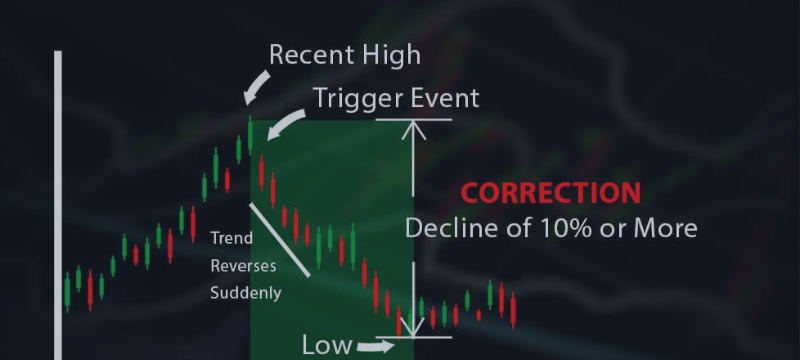In investing, a correction is usually defined as a decline of 10% or more in the price of a security from its most recent peak.1
Corrections can happen to individual assets, like an individual stock or bond, or to an index measuring a group of assets.
An asset, index, or market may fall into a correction either briefly or for sustained periods—days, weeks, months, or even longer. However, the average market correction is short-lived and lasts anywhere between three and four months.2
Investors, traders, and analysts use charting methods to predict and track corrections. Many factors can trigger a correction. From a large-scale macroeconomic shift to problems in a single company's management plan, the reasons behind a correction are as varied as the stocks, indexes, or markets they affect.
KEY TAKEAWAYS
- A correction is a decline of 10% or greater in the price of a security, asset, or a financial market.
- Corrections can last anywhere from days to months, or even longer.
- While damaging in the short term, a correction can be positive, adjusting overvalued asset prices and providing buying opportunities.
How a Correction Works
Corrections are like that spider under your bed. You know it's there, lurking, but don't know when it will make its next appearance. While you might lose sleep over that spider, you shouldn't lose sleep over the possibility of a correction.
According to a 2018 report from CNBC and Goldman Sachs, the average correction for the S&P 500 lasted only four months and values fell around 13% before recovering.3
However, it is easy to see why an individual or novice investor may worry about a 10% or greater downward adjustment to the value of their portfolio assets during a correction. Many do not see it coming and don't know how long the correction will last. For those who remain in the market for the long term however, a correction is only a small pothole on the road to retirement savings.4
The market will eventually recover, so they should not panic.
Of course, a dramatic correction that occurs in the course of one trading session can be disastrous for a short-term or day trader and those traders who are extremely leveraged. These traders could see significant losses during times of corrections.
No one can pinpoint when a correction will start, end, or tell how drastic of a drop prices will take until after it's over. What analysts and investors can do is look at the data of past corrections and plan accordingly.
Charting a Correction
Corrections can sometimes be projected using market analysis, and by comparing one market index to another. Using this method an analyst may discover that an underperforming index may be followed closely by a similar index that is also underperforming. A steady trend of these similarities may be a sign that a market correction is imminent.
Technical analysts review price support and resistance levels to help predict when a reversal or consolidation may turn into a correction. Technical corrections happen when an asset or the entire market gets overinflated. Analysts use charting to track the changes over time in an asset, index, or market. Some of the tools they use to determine where to expect price support and resistance levels include Bollinger Bands®, envelope channels, and trendlines.
Preparing Investments for a Correction
Before a market correction, individual stocks may be strong or even outperforming. During a correction period, individual assets frequently perform poorly due to adverse market conditions. Corrections can create an ideal time to buy high-value assets at discounted prices. However, investors must still weigh the risks involved with purchases, as they could well see a further decline as the correction continues.
Protecting investments against corrections can be difficult, but doable. To deal with declining equity prices, investors can set stop-loss orders or stop-limit orders. The former is automatically triggered when a price hits a level pre-set by the investor. However, the transaction may not get executed at that price level if prices are falling fast.
The second stop order sets both a specified target price and an outside limit price for the trade. Stop-loss guarantees execution where stop-limit guarantees price. Stop orders should be regularly monitored, to ensure they reflect current market situations and true asset values. Also, many brokers will allow stop orders to expire after a period.
Investing During a Correction
While a correction can affect all equities, it often hits some equities harder than others. Small-cap, high-growth stocks in volatile sectors, like technology, tend to react the strongest.5
Other sectors are more buffered. Consumer staples stocks, for example, tend to be business cycle-proof, as they involve the production or retailing of necessities.6
So if a correction is caused by, or deepens into, an economic downturn, these stocks still perform.
Diversification also offers protection if it involves assets that perform in opposition to those being corrected, or those that are influenced by different factors. Bonds and investment vehicles have traditionally been a counterweight to equities, for example. Real or tangible assets, like commodities or real estate, are another option to financial assets like stocks.
Although market corrections can be challenging, and a 10% drop may significantly hurt many investment portfolios, corrections are sometimes considered positive for both the market and for investors. For the market, corrections can help to readjust and recalibrate asset valuations that may have become unsustainably high. For investors, corrections can provide both the opportunity to take advantage of discounted asset prices as well as to learn valuable lessons on how rapidly market environments can change.
Pros
- Creates buying opportunities into high-value stocks
- Can be mitigated by stop-loss/limit orders
- Calms overinflated markets
Cons
- Can lead to panic, overselling
- Harms short-term investors, leveraged traders
- Can turn into prolonged decline
Real-World Examples of a Correction
Market corrections occur relatively often. Between 1980 and 2020, the S&P 500 experienced 18 corrections.7
Five of these corrections resulted in bear markets, which are generally indicators of economic downturns.8
The others remained or transitioned back into bull markets, which are usually indicators of economic growth and stability.9
Take 2018, for example. In February 2018, two major indexes, the Dow Jones Industrial Average (DJIA) and the S&P 500, both experienced corrections, dropping by more than 10%. Both the Nasdaq and the S&P 500 also experienced corrections in late October 2018.10
Each time, the markets rebounded. Then another correction occurred Dec. 17, 2018, and both the DJIA and the S&P 500 dropped over 10%—the S&P 500 fell 15% from its all-time high.11
Declines continued into early January with predictions that the U.S. had finally ended a bear market abounding.12
The markets began to rally, erasing all the year's losses by the end of January. And by April 2019, the S&P 500 was up about 20% since the dark days of December.13
Trading robots 🤖
Scalper ICE CUBE MT4 - https://www.mql5.com/en/market/product/77108
Scalper Lego -https://www.mql5.com/en/market/product/90776
Scalper Golden Gate - https://www.mql5.com/en/market/product/87986
EA Impuls Pro MT4- https://www.mql5.com/en/market/product/72402
Risk manager MT4 - https://www.mql5.com/en/market/product/72214
Market Screener MT4 - https://www.mql5.com/en/market/product/72380
Indicators 📈
3 in 1 Indicator iPump MT4 - https://www.mql5.com/en/market/product/72257
Power Reserve MT4- https://www.mql5.com/en/market/product/72392
This is just a shortlist of really high-quality products that will improve your trading. Almost all products have MT4 and MT5 version/
A complete list of products was created by me by the link in the profile - https://mql5.com/en/users/batudaev/seller#products



